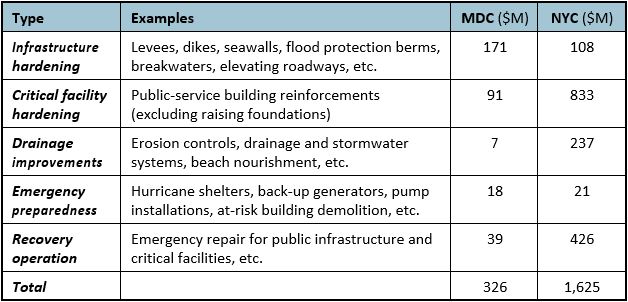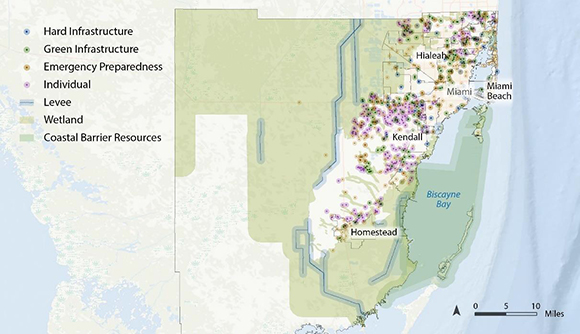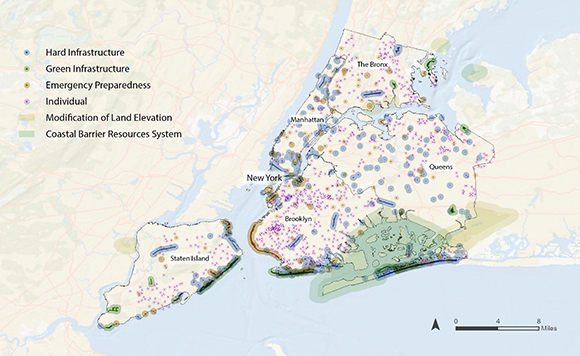The Economic Effects of Climate Change Adaptation
Despite increases in extreme meteorological events such as coastal floods and storm surges, population on the coasts continues to increase. To alleviate problems caused by the paradoxical combination of increased risk and increased population, governments in many coastal cities are spending significantly on climate-change adaptation projects. To date, however, there has been little research examining the economic effects of this spending.
In a new working paper, I examine how climate-change adaptation measures have affected real estate markets in two representative coastal areas: Miami-Dade County (MDC) and New York City (NYC), which have both experienced extreme storms. Between 2011 and 2017, these areas invested $326 million and $1.6 billion, respectively, on climate-change adaptation measures, representing roughly four and two percent of their respective annual budgets (Table 1). Moreover, homeowners in both places have made substantial investments to raise foundations, which better protects their homes from storm surges and flooding (Figures 1 and 2).
Table 1. Climate-Change Adaption Projects in MDC and NYC, 2011-2017

Sources: Miami Dade County’s Local Mitigation Strategies from 2011 Q2 to 2017 Q4 and New York Rising Community Reconstruction from 2012 Q1 to 2016 Q4.
Since climate adaptive solutions are intertwined with various externalities, I also investigated critical socio-environmental factors such as consumer risk perception, storm idiosyncrasies, and other variations in locational amenity. Not surprisingly, my results indicate that compared with home sales in other periods, single-family properties that were sold 30 to 150 days after a storm sold at a 2.4 percent and 2 percent discount in MDC and NYC, respectively.
Figure 1. Site Adaptation Measures in Miami-Dade County
Illustration: Author; Data source: Miami Dade County Local Mitigation Strategies (2018)
However, many adaptation measures had positive impacts on housing prices, though the impacts, which tended to be most pronounced for about five months after a hurricane, varied in the two locales. Most notably, natural infrastructure adaptation projects (such as green-space restoration and beach nourishment) were associated with a 9.7 percent increase in housing prices in Miami-Dade County and a 2.7 percent increase in NYC for homes that were located within 400 meters of those that sold after a major storm. Similarly, adaptations focused on mitigating the effects of storm surges, such as retrofitting seawalls and constructing breakwaters, led to a 15.8 percent increase in prices for homes in MDC and a 5.5 percent increase in NYC. And raising foundations (something homeowners often do without public funding) was associated with a 6.6 percent increase in MDC housing prices and a 14.3 percent increase in NYC.
Figure 2. Site Adaptation Measures in NYC
Illustration: Author; Data source: New York Rising Community Reconstruction (2018)
However, some other common adaptive strategies—such as improving drainage and stormwater systems, retrofitting equipment (e.g. emergency generators and portable pumps), or providing new hurricane shelters—did not impact local housing values. Presumably this is due to scale and distribution issues associated with these types of adaptation measures.
The study helps provide a clearer understanding of how different types of climate-adaptation measures interact with socio-environmental externalities, and how we might better approach the challenge of reinforcing the resilience of our coastal communities (and their economies) against the weather extremes caused by climate change. Such findings are increasingly important given that powerful coastal storms are likely to increase in the coming years.



